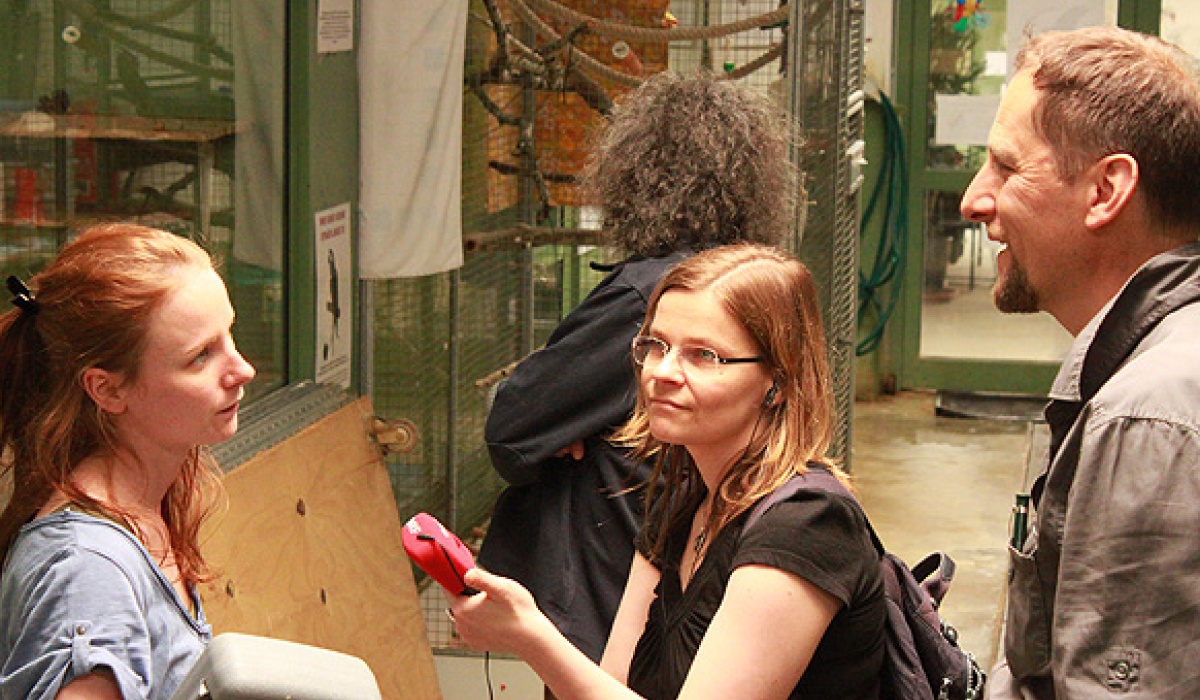
Our sound technician Martin Leitner, who is himself a passionate amateur ornithologist, has brought several microphones in order to capture the diverse parrot calls in good quality: two high-end omni-directional studio capacitors, a mid-side stereo microphone and two robust dynamic stage mics.
State of the Art
For the recordings a state-of-the-art Aaton Cantar is used, a multi-track portable sound recorder that lets you record up to eight channels and is usually used for film sound. “It is battery-operated, so I don’t need a cord,” Martin Leitner sums up the good points, “and it’s a compact all-in-one device, so I don’t need to lug around a mixing console and computer.”
Problems with the Scientific Group
So far we’ve only really spent time with the parrots of the so-called scientific group, whose curious behaviour has already been the subject of study of many an aspiring biologist. Today, however, we run into a problem. The blue-fronted Amazon parrot Hanni doesn’t like men. Martin Leitner can’t go into the aviary to set up the microphones. “Some parrots prefer men,” explains Catarina Güttner, head of the parrot shelter. “It depends on the bird’s experiences with men and women in the past. There are parrots with a preference for a particular hair colour, too.”
Mick Jagger Mic for Felix
Today we decide to start out with the so-called TV group, parrots who tend to sit still when a camera is pointed at them. This Monday afternoon the TV group isn’t very talkative, but Felix, a cockatoo in the aviary across the way, is all the more loquacious. Martin Leitner is immediately at hand with the right microphone.
Felix was raised by humans instead of by a mother parrot, Catarina Güttner explains, which is why he needs more human attention than other birds.
The Communication Behaviour of Parrots
At the parrot welfare office we catch a bit of a discussion about the communication behaviour of parrots before we head back to the radio station. Parrots are flock birds, they are very social and as such also very communicative, Catarina Güttner explains, but it’s difficult to interpret the meaning of the various whistles. Body language, at least, gives us something to go by. Parrots are especially skilled at imitation, which, incidentally, is something they also do in the wild.
“In captivity parrots imitate human speech to get close to people,” Güttner says. “It’s like a bilingual relationship. The amazing thing, though, is that parrots are also associative beings. They know that certain words will be followed by certain reactions. This leads scientists to the conclusion that parrots have the intelligence of a chimpanzee or a four-year-old child.”
Material for Further Processing
Afterwards, I ask Norbert Math and Andrea Sodomka what they are going to do with the recordings. According to Math, they are particularly interested in two aspects: “The individual sounds or sound sequences and the imitated words – we might want to modify the latter, incorporate them into our sound installations. We think that if we let the birds work with familiar sounds, they will be more inclined to play with the sound installations. It’s useless to use piano, guitar or other sounds that have absolutely nothing to do with the birds’ acoustic world.” Besides, they hope the recordings will help them understand the birds’ sound cosmos.
And, Andrea Sodomka adds, they have made some very interesting observations today: “When the parrots played with the metal bowls or tapped the windows with their beaks, that was fantastic! How parrots use things to create a racket is something that really inspires us!”
